Cite - Sainte-Chapelle
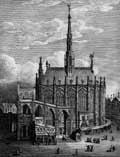 |
| View of the Sainte-Chapelle up until 1630 |
Built over a six-year period, (1242-1248), the Sainte-Chapelle ("Holy Chapel") is above all the personal work of Saint Louis. It was designed to house the relics of the Passion, in particular Christ's crown of thorns, designed to enthrone the kingdom of France as the leader in the first rank of Western Christianity in the flamboyance of the XIIIth century. It was in 1239 that Louis IX concluded the purchase of this most precious relic of the Passion with the Byzantine emperor Baldwin II, for the exorbitant sum of 135,000 livres (the chapel "only" cost 40,000 livres to build). Two years later, other relics were brought from Byzantium. Everything was placed in the palace, in the Saint-Nicolas chapel, while waiting for a more suitable setting to be found.
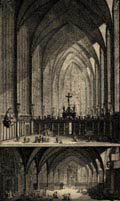 |
| The Sainte-Chapelle (upper chamber, lower chamber) |
The Sainte-Chapelle was consecrated on April 26, 1248. The upper chapel, both a royal chapel and the place where the relics were to be exhibited, was consecrated by the Pope's legate, Eudes of Chateauroux, and the lower chapel, the palace's parish, was dedicated to the Virgin Mary by Pierre Berruyer, archbishop of Bourges.
The Sainte-Chapelle, a symbol of both religion and royalty, suffered considerable damage during the French Revolution. The furniture, the stalls and the choir wall disappeared, the organs were transported to Saint-Germain-l'Auxerrois, the spire was knocked down, the tympans damaged, and the relics were scattered. Most of the statues were saved by Alexandre Lenoir. From 1846 onwards, significant restoration work was undertaken by the architects Duban, Lassus and Boeswillald, and the Sainte-Chapelle recovered its previous splendor.
The lower chapel is dedicated to the Virgin Mary, whose statue stands freely next to the central pier of the portal. It's low vaulted ceilings rest on fine columns with capitals with crochets, linked by anchor braces (pieces of wood or stone placed between two parts which tend to move towards each other). The walls are decorated with trefoiled arcades and twelve medallions which represent the Apostles.
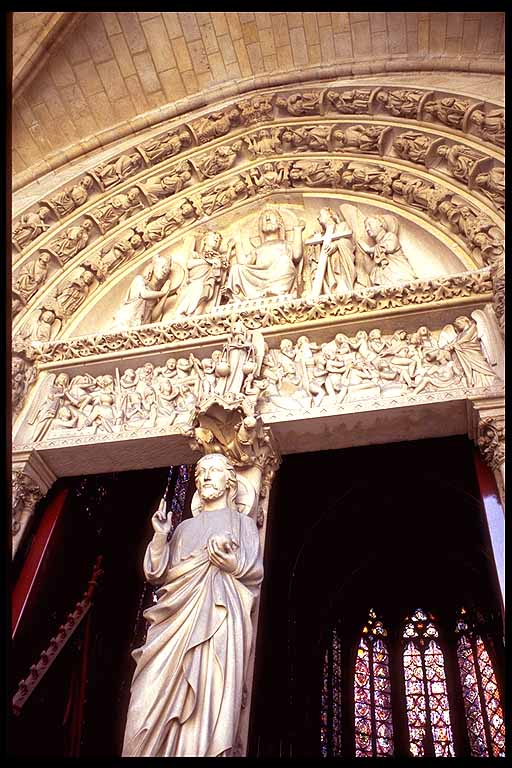
French lys on an azure background and towers of Castile alternate on the columns. The towers are a homage to Blanche of Castile, Saint Louis' mother. The vaulted ceiling has a starry sky painted on it, and the floor has tombstones that cover the sepulchres of treasurers and reverends of the Sainte-Chapelle.
In the upper chapel, full Gothic architecture is to be seen in its full sublime splendor - light, color, space, and the sentiment of harmony between art and faith. The architects, sculptors and painters evidently took the greatest care with the interior of the upper chapel, as this was the part of the building that was used as a storage area for the religious relics. The vaulted ceiling seems to float above the stained-glass windows. The imposing mass of the buttresses disappears with the artful use of an array of nine small columns, distributed in such a way as to make the volume of each pillar hardly noticeable.
The most significant sculpted decoration in the upper chapel are the statues of the twelve apostles which lean on the columns that mark the bays. There are two different styles. The first, with flowing drapes and straight creases, faces with fine traits and hair in flattened curls, gives a feeling of serenity. The second group shows how medieval statuary art developed: with straight and broken folds, it is characterized by the treatment of faces seen from the front...
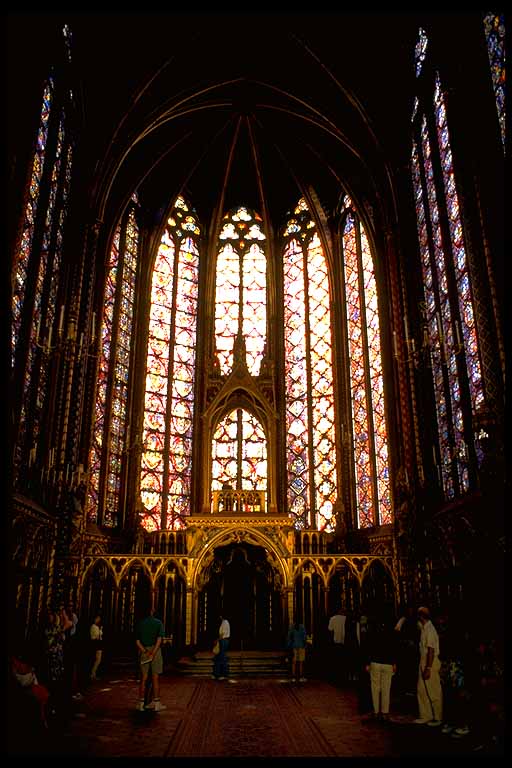
There is an infinite variety in the sculpture of the capitals and the corner pieces (corner piece: wall surface between where two arches rise). The inside of the chapel is painted, and the decoration is in harmony with the stained-glass windows. The holy relics bought by Saint Louis were kept in a large, richly decorated reliquary, placed at the summit of the open tribune, at the back of the apse. On Good Friday, they were exhibited to the faithful. In addition to the crown of thorns and a piece of the true cross, the Sainte-Chapelle's collection of relics includes a number of other key pieces mentioned in both testaments.
When the French Revolution occurred, the relics were scattered. Some disappeared, others are today kept in the treasure of Notre-Dame and the National Library. The Sainte-Chapelle was famous for its stained-glass windows. It's 600 square meters of glass, two-thirds of which is the original glass, represent the most complete example of XIIth century stained-glass craftsmanship. The reds and blues which stand out against the XVth century western rose window are the dominant colors. The elegant and elevated structure of the building is humbled by the splendor of the stained-glass windows, which tell the full story of humanity, from the Creation to redemption through Christ, through the Bible. Genesis, Exodus, Numbers, Deuteronomy, Judges, Isaiah, the Tree of Jesse, Saint John the Baptist, Daniel, Ezekiel, Jeremiah, Tobias, Judith and Job, Esther, the Book of Kings, and the History of the Relics follow on from one. Each window, divided into arches, reads from left to right and from top to bottom. Following the disaffection of the Sainte-Chapelle in 1803, its stained-glass windows were stored in a two-meter space in order to use the building as storage space for archives. They were admirably restored in the XIXth century.
The Triumph of the Immaterial
Attributed to Pierre of Montreuil, the Sainte-Chapelle is a masterpiece of transparency. The wall disappears to give way to the stained-glass windows cantoned by an array of small columns that reach up to the arches of the vaulted ceiling. This Chapelle palatine (palatin(e): related to the palace), is a chapel of the private chapel type, built on two levels. The king and his close friends and family accessed the upper chapel directly via the outside gallery which was joined to the palace. The lower chapel was reserved for palace staff.
Gothic art had reached its perfection in the XIIth century. The Sainte-Chapelle's architectural model is that of a building with a single nave, which finishes in a chevet with seven panels. Outside, the architecture concentrates on the essentials - a sober base and heavy buttresses contrast with the lightness of the upper parts. The slate roof is dominated by the spire made of cedar, 33 meters high, a masterpiece of finesse, made in the XIXth century, but an exact replica of the XVth century spire.
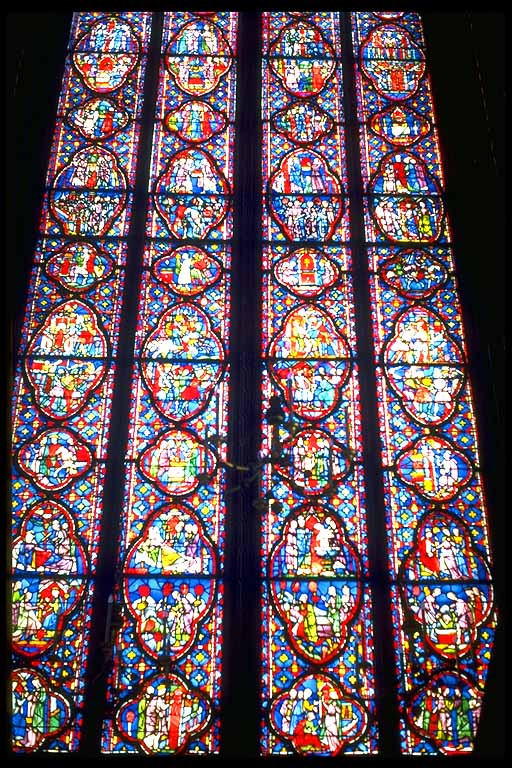
The interior of the lower chapel gives an impression of mystery with its low ceilings (6.60 m) with four bays and a rayonnant choir, its walls broken up by the arcades and fine columns supporting the vaulted ceiling and its precious and delicate decoration. In contrast to this, the upper level strikes us with the simplicity of the space defined, invaded by colored light. The supports and ribs disappear, and the verticality is accentuated by the fact that the arches start high up, emphasized by the statues of the apostles. The building seems small, high and airy, even though its height (20.50 m) is not twice its width (10.50 m). This impression is entirely due to the architect's painstaking calculations which accentuate the perspective effect by playing on the thickness of the ribs or the height of the stained-glass windows, by creating a horizontal chain of iron which crosses pillars and mullions and coincides with the barlotieres of the stained-glass windows (barlotiere: element of the metal frame of a stained-glass window on which the panel rests).